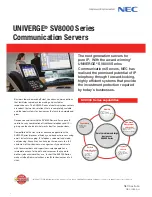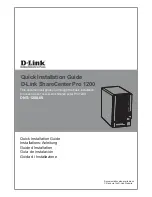
Guidelines
for
servicing
electrical
equipment
Observe
the
following
guidelines
when
servicing
electrical
equipment:
v
Check
the
area
for
electrical
hazards
such
as
moist
floors,
nongrounded
power
extension
cords,
power
surges,
and
missing
safety
grounds.
v
Use
only
approved
tools
and
test
equipment.
Some
hand
tools
have
handles
that
are
covered
with
a
soft
material
that
does
not
provide
insulation
from
live
electrical
currents.
v
Regularly
inspect
and
maintain
your
electrical
hand
tools
for
safe
operational
condition.
Do
not
use
worn
or
broken
tools
or
testers.
v
Do
not
touch
the
reflective
surface
of
a
dental
mirror
to
a
live
electrical
circuit.
The
surface
is
conductive
and
can
cause
personal
injury
or
equipment
damage
if
it
touches
a
live
electrical
circuit.
v
Some
rubber
floor
mats
contain
small
conductive
fibers
to
decrease
electrostatic
discharge.
Do
not
use
this
type
of
mat
to
protect
yourself
from
electrical
shock.
v
Do
not
work
alone
under
hazardous
conditions
or
near
equipment
that
has
hazardous
voltages.
v
Locate
the
emergency
power-off
(EPO)
switch,
disconnecting
switch,
or
electrical
outlet
so
that
you
can
turn
off
the
power
quickly
in
the
event
of
an
electrical
accident.
v
Disconnect
all
power
before
you
perform
a
mechanical
inspection,
work
near
power
supplies,
or
remove
or
install
main
units.
v
Before
you
work
on
the
equipment,
disconnect
the
power
cord.
If
you
cannot
disconnect
the
power
cord,
have
the
customer
power-off
the
wall
box
that
supplies
power
to
the
equipment
and
lock
the
wall
box
in
the
off
position.
v
Never
assume
that
power
has
been
disconnected
from
a
circuit.
Check
it
to
make
sure
that
it
has
been
disconnected.
v
If
you
have
to
work
on
equipment
that
has
exposed
electrical
circuits,
observe
the
following
precautions:
–
Make
sure
that
another
person
who
is
familiar
with
the
power-off
controls
is
near
you
and
is
available
to
turn
off
the
power
if
necessary.
–
When
you
are
working
with
powered-on
electrical
equipment,
use
only
one
hand.
Keep
the
other
hand
in
your
or
behind
your
back
to
avoid
creating
a
complete
circuit
that
could
cause
an
electrical
shock.
–
When
using
a
tester,
set
the
controls
correctly
and
use
the
approved
probe
leads
and
accessories
for
that
tester.
–
Stand
on
a
suitable
rubber
mat
to
insulate
you
from
grounds
such
as
metal
floor
strips
and
equipment
frames.
v
Use
extreme
care
when
measuring
high
voltages.
v
To
ensure
proper
grounding
of
components
such
as
power
supplies,
pumps,
blowers,
fans,
and
motor
generators,
do
not
service
these
components
outside
of
their
normal
operating
locations.
v
If
an
electrical
accident
occurs,
use
caution,
turn
off
the
power,
and
send
another
person
to
get
medical
aid.
Safety
ix
Summary of Contents for System x3400 Type 7973
Page 1: ...System x3400 Types 7973 7974 7975 and 7976 Problem Determination and Service Guide...
Page 2: ......
Page 3: ...System x3400 Types 7973 7974 7975 and 7976 Problem Determination and Service Guide...
Page 8: ...vi System x3400 Types 7973 7974 7975 and 7976 Problem Determination and Service Guide...
Page 18: ...xvi System x3400 Types 7973 7974 7975 and 7976 Problem Determination and Service Guide...
Page 34: ...16 System x3400 Types 7973 7974 7975 and 7976 Problem Determination and Service Guide...
Page 104: ...86 System x3400 Types 7973 7974 7975 and 7976 Problem Determination and Service Guide...
Page 112: ...94 System x3400 Types 7973 7974 7975 and 7976 Problem Determination and Service Guide...
Page 182: ...164 System x3400 Types 7973 7974 7975 and 7976 Problem Determination and Service Guide...
Page 192: ...174 System x3400 Types 7973 7974 7975 and 7976 Problem Determination and Service Guide...
Page 200: ...182 System x3400 Types 7973 7974 7975 and 7976 Problem Determination and Service Guide...
Page 209: ......
Page 210: ...Part Number 31R2197 Printed in USA 1P P N 31R2197...












































